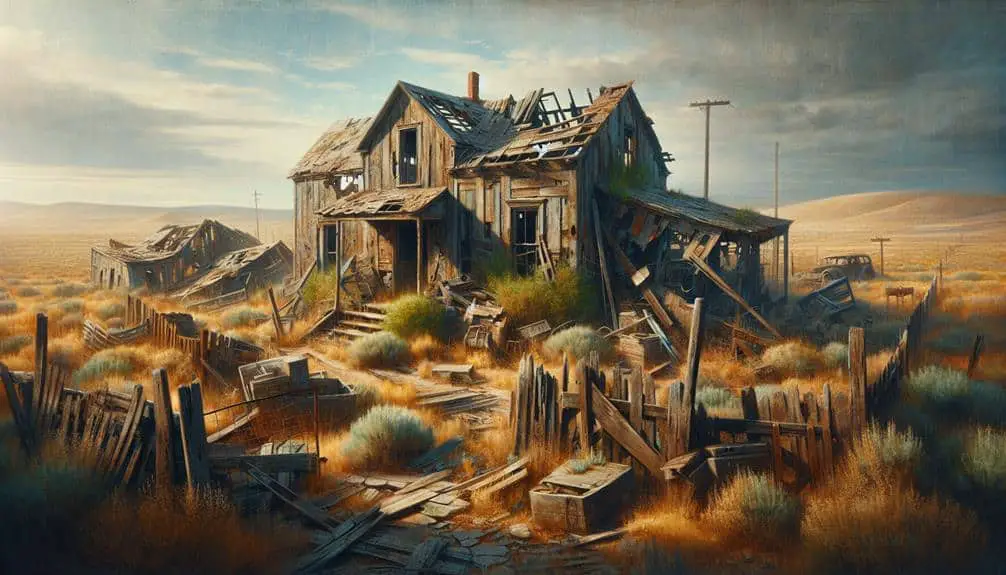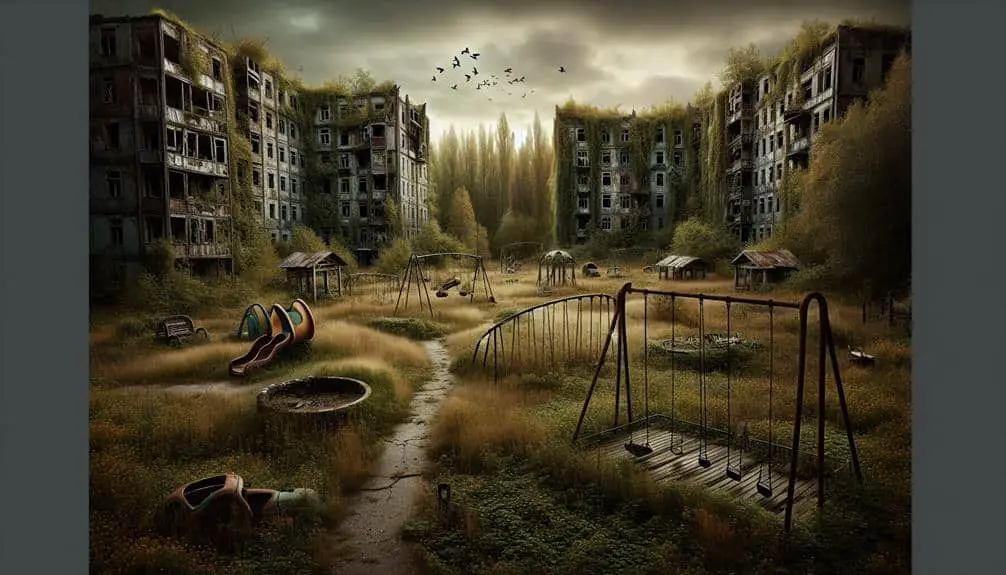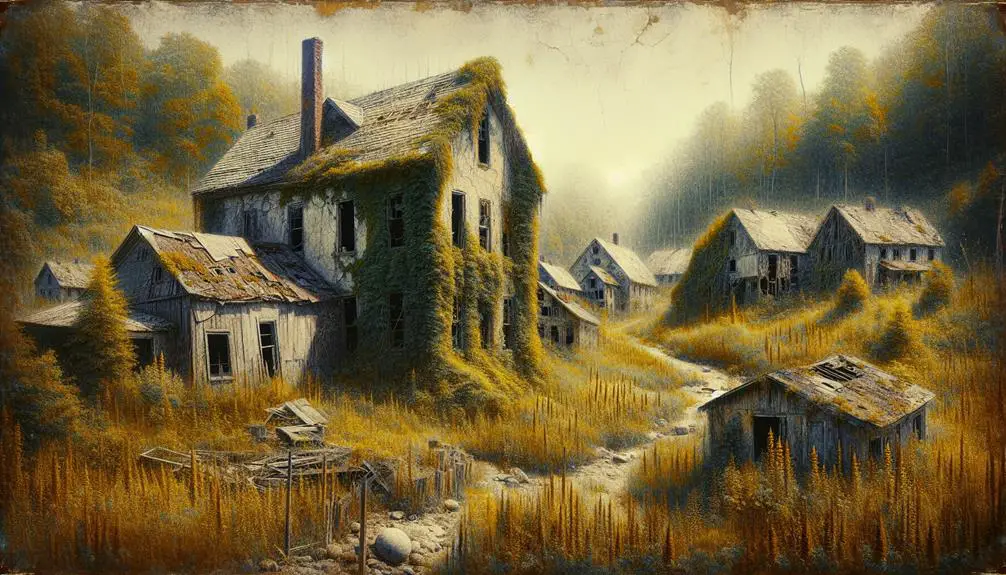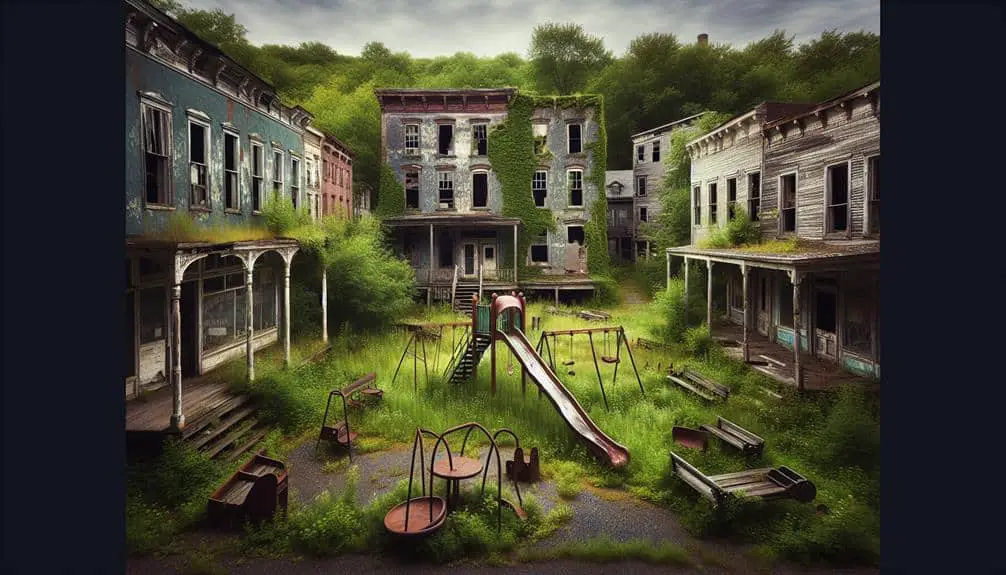Exploring failed utopian community remains in America reveals abandoned structures and architectural relics. These remnants offer insights into past grand visions and ultimate downfall. Notable examples include New Harmony in Indiana and Oneida Community Mansion House in New York. The decline of these communities resulted from economic challenges like scarce resources and leadership disputes hindering cohesive progress. Today, these ruins serve as reflections of human aspirations, cautionary tales, and inspiration for innovation. Vital efforts play a pivotal role in documenting the rise and fall of these utopian experiments, providing tangible links to diverse societal experiments in American history.
Key Points
- New Harmony in Indiana and Oneida Community Mansion House in New York are notable ruins.
- These ruins offer insights into past utopian visions and subsequent decline.
- Failed utopian communities serve as cautionary tales and inspire innovation.
- Preservation of these ruins is crucial for documenting diverse societal experiments.
- Archaeological discoveries provide tangible links to the history of utopian communities.
Origins of Utopian Settlements
Utopian settlements in America emerged during the 18th and 19th centuries as visionary experiments aimed at creating ideal communities based on shared beliefs and values. Founder motivations varied widely, ranging from religious freedom to social equality and economic cooperation. These utopian communities often centered around communal living, where individuals pooled resources and lived together in pursuit of a common vision.
The founders of these settlements were driven by a desire to escape societal norms they found restrictive or unjust. Seeking a better way of life, they envisioned communities where all members could live harmoniously and support each other. Communal living played a significant role in these utopian experiments, fostering a sense of unity and cooperation among residents.
Despite the noble intentions behind these ventures, challenges such as internal conflicts, economic struggles, and external pressures often led to their eventual decline. By delving into the motivations of the founders and the dynamics of communal living, we can better understand the origins of these utopian settlements and the factors that influenced their fates.
Reasons for Community Decline
Despite the initial enthusiasm and communal spirit that characterized many utopian settlements, various factors contributed to their eventual decline and dissolution. When examining the reasons for community decline, two significant factors stand out: economic challenges and leadership disputes.
- Economic Challenges:
- Scarce resources and financial instability often plagued utopian communities, leading to struggles in sustaining basic needs and infrastructure.
- Dependence on external economies and markets sometimes resulted in the failure to adapt to changing economic conditions.
- Leadership Disputes:
- Conflicts among leaders regarding decision-making authority and community direction could create divisions and hinder cohesive progress.
- Lack of effective leadership succession plans often led to power struggles and instability within the community.
These challenges, compounded by internal conflicts and external pressures, were instrumental in the decline of many utopian settlements across America. Understanding these factors sheds light on the complexities that communities faced in their pursuit of utopian ideals.
Notable Utopian Community Ruins
Amidst the vast landscapes of America, remnants of once-thriving utopian communities now stand as poignant reminders of ambitious dreams and eventual realities. These architectural relics and abandoned structures offer a glimpse into the past, showcasing the grand visions and ultimate downfall of these utopian experiments.
One notable ruin is the New Harmony community in Indiana, founded by Robert Owen in the early 19th century. The town's original buildings, such as the Rapp-Owen Granary and the Roofless Church, still stand as affirmations to Owen's ideals of communal living and education.
Another striking example is the ruins of the Oneida Community Mansion House in New York, where the Oneida Perfectionists once thrived. The abandoned structure reflects the community's unique social and religious beliefs that promoted equality and complex marriage practices.
Exploring these notable utopian community ruins allows for a deeper understanding of the aspirations and challenges faced by those who sought to create ideal societies in the American landscape.
Impact of Failed Utopias Today
In modern society, the remnants of failed utopian communities continue to serve as tangible reminders of the complexities inherent in idealistic social experiments. These abandoned utopias hold a modern significance that goes beyond their historical context, influencing cultural evolution in various ways:
- Reflection of Human Aspirations: The ruins of failed utopian communities remind us of humanity's enduring quest for a better society, showcasing both the noble intentions and practical challenges faced by such endeavors.
- Cautionary Tales: These remnants stand as cautionary tales, warning against the pitfalls of idealism without practicality, and the importance of balancing lofty goals with realistic implementation strategies.
- Inspiration for Innovation: The failures of past utopian experiments inspire contemporary thinkers to approach societal issues with fresh perspectives, encouraging innovative solutions that learn from the mistakes of the past.
- Preservation of Diversity: By preserving the history of failed utopian communities, we uphold the value of diverse ideologies and experiments, contributing to the rich tapestry of cultural heritage and social discourse.
Preserving Utopian Community History
The significance of failed utopian communities extends into the present through efforts aimed at preserving their history and lessons for future generations. Historical preservation plays a pivotal role in ensuring that the stories of these communities aren't lost to time. By documenting the rise and fall of these utopian experiments, researchers and historians can offer valuable insights into the factors that contribute to both success and failure in communal living arrangements.
Archaeological discoveries provide tangible links to these past communities, uncovering artifacts and structures that offer clues about daily life and beliefs. These findings help piece together the puzzle of utopian ideals and the realities faced by their inhabitants. Through careful excavation and analysis, archaeologists can reconstruct aspects of these communities that may have otherwise been forgotten.
Preserving utopian community history serves as a reminder of the diverse experiments that have shaped American society. By learning from the past, we can better understand the challenges and opportunities that arise when individuals come together to pursue shared visions of a better world.
Frequently Asked Questions
What Role Did Religion Play in the Formation of These Failed Utopian Communities?
Religious influence in failed utopian communities varied, shaping values and norms. For example, in Jonestown, cult leader Jim Jones used religion to control followers. Community dynamics were often centered on shared beliefs, fostering unity or discord.
How Did the Residents of These Communities Interact With Neighboring Towns and Cities?
You interacted with neighboring towns and cities in various ways. Cultural exchanges brought new ideas, while economic integration affected trade. These interactions influenced the dynamics between your utopian community and the surrounding areas, shaping your shared histories.
Were There Any Instances of Conflict or Violence Within These Utopian Settlements?
In utopian settlements, conflict resolution was pivotal. Communal living dynamics often led to tensions, but violence was rare. Residents navigated disputes through dialogue and consensus-building. By prioritizing harmony, these communities aimed for peaceful coexistence.
What Impact Did the Decline of These Communities Have on the Surrounding Environment?
The decline of these communities had a significant environmental impact as abandoned structures deteriorated, disrupting ecosystems. Community integration waned, leading to neglect of agricultural practices and waste management, affecting local flora and fauna.
Are There Any Efforts Being Made to Repurpose the Ruins of These Utopian Settlements for Modern Use?
You can witness the ruins of failed utopian ideals. Efforts are underway to repurpose these remains for sustainable development. By preserving history and fostering progress, these sites can become symbols of resilience and innovation.



